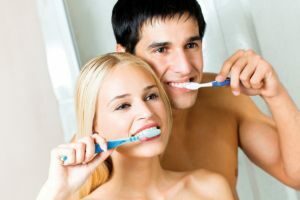 Healthy teeth are not only a beautiful open smile, but also the right process of digestion, normal metabolism, and the health of the body as a whole.
Healthy teeth are not only a beautiful open smile, but also the right process of digestion, normal metabolism, and the health of the body as a whole.
The pledge of healthy teeth, the prevention of dental diseases, inflammatory diseases of the gums and soft tissues of the oral cavity is the daily oral hygiene of the mouth and teeth.
Regular care for teeth and oral cavity reduces the risk of various diseases by 80%.
Therefore, it is so important to know how to take care of your teeth correctly, and do not forget to apply this knowledge in practice, adhere to a balanced diet, regularly visit dental hygienists for professional dental cleaning from plaque and tartar.
Contents
- Daily dentifrice
- Oral hygiene products
- Stage one - choice of toothbrush
- Stage two - purchase of irrigator
- Stage three - choice of paste
- Mouthwash
- Basics of nutrition
- Memo to parents
- Professional oral hygiene in dentistry
Daily proceduretooth cleaning
The first rule of maintaining the health of the teeth is a systematic cleansing from the remains of food. The procedure is carried out at least twice a day. Duration of manipulation - from 3 to 5 minutes.
There are different ways to brush your teeth, but in most cases, experts recommend using a universal method.
It consists of the following sequential manipulations:
- The procedure starts with the cleaning of the front teeth ( smile zone).The toothbrush is at an angle of 45 degrees. The movements of the brush are from the gum to the cutting surface of the teeth.
- First of all, is used to clean the outside of the teeth, then - the internal .To clean the inner surface of the front teeth is necessary, directing the motion with a brush forward.
- The chewing surfaces of the side are cleaned by moving the brush from the front to the back.
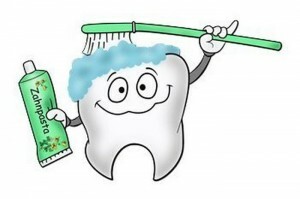
- Acting methodically, first clean the teeth of the upper jaw, then pass to the lower jaw of the .
- If the soft tissues of the oral cavity are healthy, the symptoms of periodontal disease are absent, during universal tooth cleaning is recommended to conduct preventive massage of the gums .For this, circular movements are made on the surface of the tooth with a brush, with a call to the gum.
- The method of gentle cleaning of teeth is recommended for people with gum disease, so as not to damage soft tissues. In this case, the movements of the toothbrush are directed only from the top to the bottom for the top and bottom to the top for the lower jaw.
- The cheek surfaces of the chewing teeth of are cleaned from plaque by moving the brush back and forth. In this case, the jaws must be closed.
- The inner surfaces of the teeth of the upper and lower dentition of the tooth are cleaned in the same manner, slightly opening the mouth.
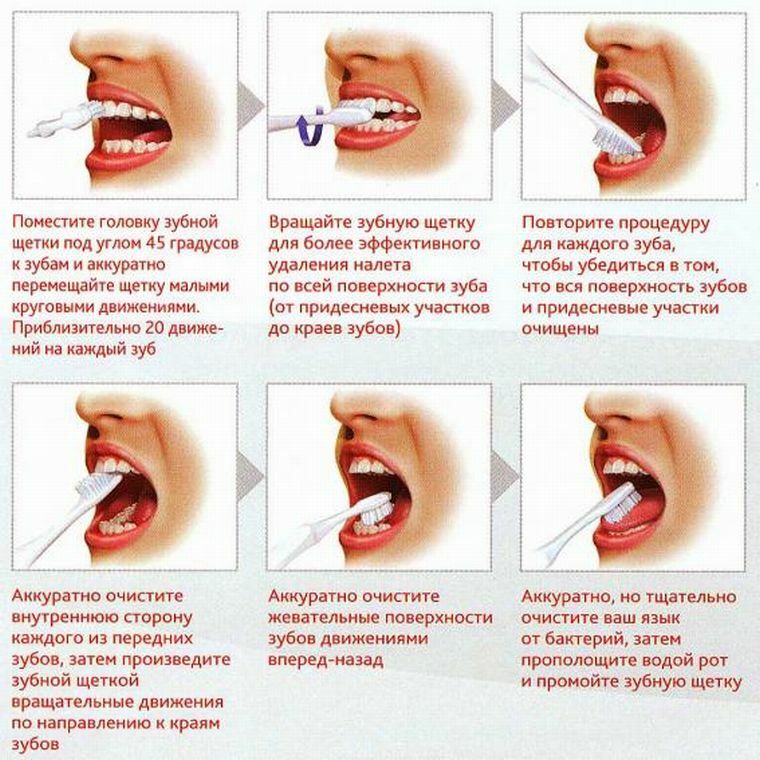
Food particles falling into the interdental space are removed using flosses - special dental floss. A strong thin thread is wound on the index fingers and methodically held between the teeth. After cleaning, the floss is discarded.
Means of oral hygiene
Competent care consists not only in regular cleaning of teeth, but also in the ability to choose the right means for oral hygiene.
Step One - Selecting the Toothbrush
When choosing a toothbrush, for example, the focus should be on the stiffness of the bristles.
The classification of toothbrushes according to the degree of rigidity is as follows:
- with ultra soft and soft bristles is recommended for people with increased sensitivity of teeth, bleeding gums, inflammatory processes in the oral cavity.
- medium-hardness brushes are the most common. Most people use them.
- Rigid and ultra-rigid toothbrushes are recommended by dentists only to persons with a tendency to form a strong plaque. In this case, any gum disease is a contraindication to the use of brushes with stiff bristles.
In addition, brushes are standard( conventional), orthodontic and highly specialized therapeutic.
According to the material of manufacture, the bristles are divided into natural and synthetic bristles, differ in the area of the cleaning surface, in the number and arrangement of the rows of the bristles.
Stage two - purchase of irrigator
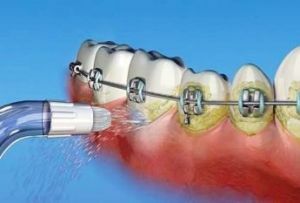 With significant problems with teeth and gums, when a toothbrush can not be used due to painful sensations, the irrigator comes to the rescue. This is a special portable device, which supplies a powerful pulsating jet of water to the surface of the teeth and gums.
With significant problems with teeth and gums, when a toothbrush can not be used due to painful sensations, the irrigator comes to the rescue. This is a special portable device, which supplies a powerful pulsating jet of water to the surface of the teeth and gums.
The effectiveness of brushing teeth when using the irrigator is increased several times, since the device allows to remove plaque and food residues even in places inaccessible to the toothbrush.
In addition, a strong stream of inlets produces massage of the gums, stimulates local blood circulation, strengthens soft tissues.
Stage Three - Selecting the
Paste The choice of toothpaste depends on what problems you need to solve at the moment:
- So, for daily dentistry procedures hygienic paste is suitable. They remove the soft plaque well and give fresh breath.
- Prophylactic is used to prevent major dental and inflammatory diseases of the oral cavity. The composition of such products usually includes the necessary for the maintenance of dental health minerals( fluoride, calcium, phosphorus), extracts of medicinal plants, biological supplements, antimicrobial substances.
- Toothpastes with curative effect should appoint a dentist. The composition of such drugs can be different, the action is aimed at treating a particular disease of the gums, teeth.
- whitening pastes contain special chemical compounds, abrasive components, acids. They bleach the enamel well, but it is allowed to use these compounds no more than 2-3 times a week.
Mouthwash
After cleaning, the mouth should be thoroughly rinsed with water, and preferably a mouth rinse. Many believe that these oral hygiene products are needed only to freshen your breath. This is not true.
The composition of modern mouthwashers includes bioactive components that reduce bleeding gums and tooth sensitivity, preventing the development of caries, periodontitis, gingivitis, and other diseases.
Rinse mouth with elixir for 30 seconds. Then spit. If possible, the liquid must be "filtered a couple of times through the teeth to reach for soft tissues located in hard-to-reach places.
In order to instill in the mouth the perfect purity, in addition to the standard devices and means for oral hygiene in daily home dental care, special brushes are needed to clean hard-to-reach areas, scrapers to remove plaque from the tongue.

Rinse mouth from time to time with beet juice or infusion of beetroot leaves. This remedy is an excellent prophylaxis for inflammatory gum disease and helps to eliminate bad breath.
From the bleeding gums help to get rid of the juice of the leaves of plantain. A preventative measure against inflammatory diseases is rinsing of the oral cavity with watery plantain infusion.
Power Basics
Hygiene of the oral cavity and teeth is also proper nutrition. There are products useful for teeth and gums, but there are also those that can cause them harm and cause serious problems.
To useful products include: 
- milk and dairy products;
- is cereal;
- fish and seafood;
- meat products;
- tea green, floral;
- nuts.
Raw food of vegetable origin, including vegetables and fruits with hard flesh in raw form, green vegetable crops is useful for teeth and gums.
The formation of a stable soft plaque and hard tartar is promoted by acid varieties of apples, lemons, grapes, broth of wild rose. Rubbed, fatty, soft foods, as well as flour products are undesirable too often included in the diet.
All kinds of fast food, confectionery, candy, chocolate, muesli, popcorn, chips, chewing sweets, bars are among the most dangerous products. To the drinks, harmful to the teeth, fruit juices, any energy, sweet sodas, lemonades are considered.
Memo to parents
To a child's teeth were healthy, to teach the baby to personal hygiene is necessary from the age of two. The duty of parents is to teach the child the proper use of the toothbrush and paste, control the regularity of hygiene procedures.
It's also important to tell a baby that it's so popular why it's so important to clean your teeth every day, and what can happen if you do not.
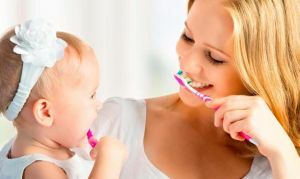 Toothbrushes should be purchased specially designed for children's teeth - with soft bristles and a small working surface. Pastes, mouthwashers also need to buy special, designed for children.
Toothbrushes should be purchased specially designed for children's teeth - with soft bristles and a small working surface. Pastes, mouthwashers also need to buy special, designed for children.
On the shoulders of parents is also the task of ensuring a properly balanced diet. The child's diet should consist of foods that contain calcium, potassium, fluoride, phosphorus, protein, vegetable fiber in large quantities. The use of harmful products should be strictly limited.
For the first preventive examination to the dentist the child must be taken away at the age of 3 years. This is extremely important, since tooth decay begins to develop precisely in childhood. Timely treatment will prevent the progression of the disease and will allow to keep healthy teeth, which are not damaged by caries.
Professional oral hygiene in dentistry
Once a year, dentists recommend professional dental cleaning. The purpose of the procedure is to remove soft and hard plaque from the surface of the teeth, in the circumgasic and interdental space. The procedure is performed using hardware or manual techniques. Time takes no more than an hour.
Thanks to regular professional cleaning of teeth, the dental hygienist at times reduces the risk of caries, periodontitis and periodontitis. 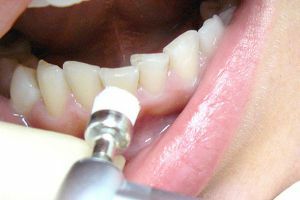
In addition, when removing pigmented plaque, the color of the enamel becomes lighter on several tones, and as a result of the use of special polishing pastes and gels, the enamel of the tooth becomes stronger, becoming less sensitive to the effects of destroying substances.
Thus, regular visits to a doctor, timely treatment of diseases, professional dental cleaning at the dentist along with strict observance of oral hygiene at home and proper nutrition is the most effective measure for the prevention of various dental diseases.
Remember, dental health depends entirely on the degree of responsibility, actions and lifestyle of a person!
